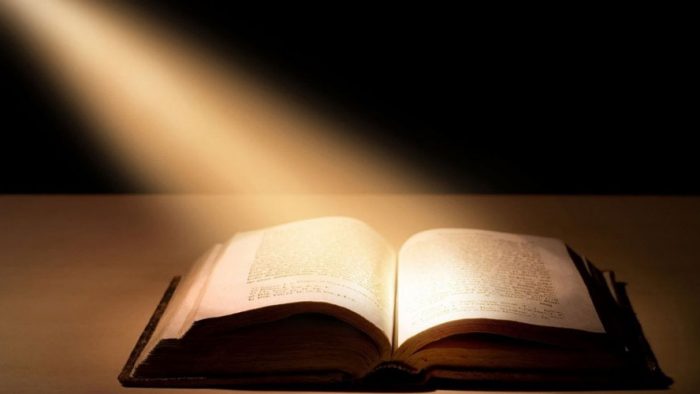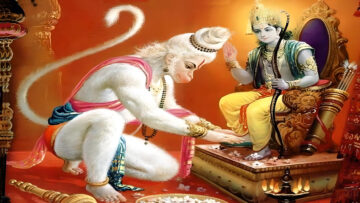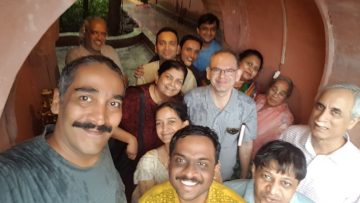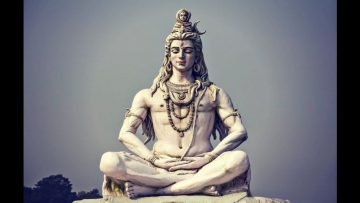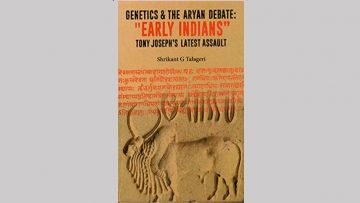Kumarila Bhatta and the other great scholars of the Purva Mimamsa were in the frontline of the battle to save Vedic heritage and culture. They were eclipsed by the great Vedanta sages who followed them, but in a conversation with C.K. Shridhar, scholars from Chennai and Poona offer deep insights into their valuable contributions.
It was the Vedic adherents known as the Mimamsakas who first revived and defended the Vedic religion in the latter half of the first millennium, not only from the strong Buddhist challenge, but from internal dissonances, paving the way for the great Vedantins to come, starting from Shankara Bhagavatpada.
While Mimamsa refers to all Vedic enquiry, the term has become associated with the ‘Karma Kandins,’ those who extolled the virtues of the Karma Kanda (Mantra and Bramhana) portions of the Veda, thus known as the Purva Mimamsa. This is in contrast to the ‘Gnyana Kandins,” the Vedantins, who focused on the Upanishads (the Uttara Mimamsa).
Even the great Sutras, the bed rock on which an entire edifice of “Bhashyas” or commentaries were built, hewed to this distinction. Jaimini wrote his Sutras enquiring into “Dharma” while Badarayana’s subject was “Brahma” jignyasa. It was the Brahma Sutra which drew the great Bhashya from Shankara, one of the world’s towering intellectual achievements.
Of course, the great acharyas were careful to see it in unity – Ramanujacharya for example, would always talks about “Purvottara Mimamsa” referring to both the Poorva and Uttara Mimamsa holistically.
Over the years, however, especially with 20th century Hindu institutions focusing rather exclusively on Vedanta, specifically Advaita, along with, in some cases, a false, Western-inspired notion of emphasising the superiority of the “spiritual” over the “ritualistic,” the Mimamsa has often got the short shrift.
A pity, because the great Mimamsakas, like Kumarila Bhatta, not only upheld the role of the Ritual, the Vedic Karma, and the Vedic Injunction (Vidhi), but had valuable things to say with regard to linguistics, epistemology and hermeneutics.
It was a rare privilege and exhilarating intellectual exercise therefore to engage a handful of modern Mimamsakas in a 55 minute discussion on the above issues, that too in hallowed environs – within Melphazur Mana, the maternal birth home of Adi Shankara, situated in the Chinmaya International Foundation and Chinmaya Vishwavidyapeeth campus at Veliyanad, in Kerala.
The scholars were there to participate in a two day workshop on the Mimamsa Shastra, organised by Chinmaya Vishwavidyapeeth, supported by Indic Academy, towards the end of December, 2018.
After a tiring day of scholarly exchanges in fluent Sanskrit covering linguistics (vṛttivicāra), epistemology (pramāṇavicāra), and hermeneutics (adhikaraṇavicāra), Dr R Mani Dravid Sastri (Chennai), Dr K.S. Maheswaran (Chennai), and Rajeshwara Sastri Deshmukh (Pune), readily agreed to a one hour interview discussion, in English, Tamil and Hindi – we settled ourselves down on the raised platform at the Poomukham, where visitors are received, in the front of Melpazhur Mana.
Not far away, on the other side of the central courtyard (Nadumottom) of the Nalukettu house, on the Eastern wing, is the birth room of Shankara Bhagavatpada, where a constantly burning lamp is a living presence…
Q: Today, most people know the three great Acharyas, and other figures in our “sant parampara,” and many are familiar with the concepts of Vedanta. But don’t Mimamsakas like Kumarila Bhatta, and their works like the Varthikas, need to be better known?
A: (Dr R Mani Dravid Sastri): Indeed yes, Kumarila Bhatta wrote granthas – Varthikas — explicating Sabara’s commentary (Bhashya) on Jaimini’s Sutras. The Varthikas do more than just explain Sabara’s commentary. They also examine what the Bhashya is saying and whether it is correct. Unfortunately, only sections of these works have survived. If you study these texts you will see how intelligently Bhatta has examined the issues. If Sabara, the Bhashyakara, shows a little ashraddha, let us say, Kumarila will spot it and take him to task for it.
I will give you an example. As you know, the Veda is Apourusheya (not produced from human effort), and thus known as Shruti, while the writings of the rishis are known as Smrithi. The Smrithi becomes Pramana (Evidence, Proof, Sanction) only when the pronouncement is based on the Veda. If a pronouncement is against the Shruti, what do you do? Sabara said it is not pramanam and has to be kept aside.
Kumarila Bhatta proceeded to examine this. He said: “In the Veda itself there are several portions (Pakshas). How do we know that this particular Smrithi text is not adhering to some part of the Veda we don’t know about?’ If you stamp the seal of ‘a-pramanam’ in one place, doubt will be raised as to the whole. It will be as if, “Oh, the rishis can make mistakes.” Instead, simply say that for those Smrithi pronouncements for which we have not located the Vedic basis, let us not take these for anushtanam. (Practice or performance). Where the source is clear let us keep that for anushtanam. Like this, he protected Smrithi pramanam. Where shishtacharam (Ideal or good practice) is pramanam the pramanyam of shishtacharam has been specially protected by Kumarila. In the Sabara Bhashya many things like this are tossed to the winds.
Q: There is a view, emphasised by some scholars, that Shankara Bhagavatpada has written against Bhatta and the Purva Mimamsa, that he devalued it, may be because many extreme practices had come into Hinduism. How correct is this? After all, we consider Kumarila Bhatta as someone who fought for the Veda itself. And do we, in Bhatta’s works, get the sense that he specifically extolled the Karma Kanda?
A: (Dr Mani Dravid Sastri): He was definitely one who fought for the whole Veda but why we specifically point to the fact that he fought for the Karma Kanda is because, during his period, it was the Karma Kanda that was the focus of the challenge mounted by the Boudhdhaas (followers of the Buddha).
As for Shankara, it was not as if he rejected everything that Bhatta said. Shankara says that whatever Kumarila Bhatta has opined you keep for the Karma Kanda alone and don’t bring it into the Vedanta. In fact, Shankara fully accepts what Bhatta says as far as the Karma Kanda goes. This is evident in the Brahma Sutra Bhashya itself. But don’t bring this into the Vedanta, is his main point, and it is only here that he criticises Bhatta.
As for Bhatta, in his time, Dharma Anushtanam was in danger. Saving it was Bhatta’s mission. If you look at some sentences, he went to the extent of saying that even the Vedanta was for the purpose of the Karma Kanda only. But in no way did he decry the Vedanta. When a discussion on the Aatman comes up in the Bhashya, Bhatta himself says that for more on this, we have to read the Vedanta.
A: (Dr K.S. Maheswaran): In those times we will have to look at the Charitram with which everybody is familiar with. Before that there was the Buddha. Different shishyas including King Ashoka, attempted to spread this Buddhist philosophy. Today we have so many different religions here which have come from different parts of the world. In a way, for all these religions, Buddha is a model, a model of how to take a constitution-based approach, so to say. This model was in full force during the time of Bhatta and Shankara.
When we read some traditional accounts, it sounds as if there was a lot of clash and conflict within our scholars. It sounds as if they were fighting amongst themselves. But this so called fight was more of a Sastrik upheaval which is there even now. Even now we have these disputes between Dvaita, Visihitadvaita and Advaita. But these are all the utkarshas of different Darshanas. All these discussions were aimed at fine tuning these Darshanas. There have been no sharirika kalahangal. All sharirika kalahangal have been by devotees, like Shiva devotees fighting with Vishnu devotees, but people who wrote the granthas did not have such fights, the Acharyas who wrote the granthas did Vichara, Shishyadhyapanam and pracharam. That is they examined, taught their disciples and propagated a view. That is all.
If you even look at the stories of Shankara Bhagavatpada sometimes you get the impression that he went to different places and created conflict. But that is not true. Only Vichara took place. Healthy debates took place. We can also see how much effort Bhatta put in to counter the Buddhist attack.
There is a story that he infiltrated a Bouddha group cutting his shikha and sacred thread and in the end doing prayaschittam and even tushadahanam. We don’t know today whether it happened exactly like this. But he wanted to fully assimilate and understand what the Bouddhas were saying. How much Shraddha he must have had, how much courage and commitment to fight for Dharma.
In Shankara’s Bashya there is something called Devata Adhikaranam, where he has said that the Varnashrama Dharma is in decline! People say, what then of today? However, in my individual opinion, times may have been even tougher those days. To properly follow a Dharma anushtanam, I have to be dressed like this but no one is attacking me. In those days one feels that they may even have been attacked. Then because of Shankara’s travels around the country, Dharma may have made a comeback. As for Bhatta, he only had time to write his works and teach disciples. He did not have enough life to propagate his views. Then there is of course the famous legend that Shankara came and defeated Bhatta’s disciple Mandana Mishra, and brought him over to his views. Shankara promoted the Gnyana Kanda, but without being against the Karma Kanda. What I am saying is, Bhatta embarked on the path of Dharma and Shankara picked up from where he left off. We should also of course remember Prabhakara Bhatta, who may have been Kumarila’s student.
A: R S Deshmukh: You referred to some Vedanta followers dismissing Karma Kanda, or even the Mimamsakas. But no authoritative figure in Vedanta has ever been totally against the Karma Kandam. Not even one. Like Shankara or Gyaneshwar Maharaj or Tukaram in our Sant Parampara. All of them say that what is in the Sruthi is the Ultimate truth. And Karma Kanda is very much part of the Sruthi. Both the Gnyana marga and the Karma marga are told by the Sruthi. There is no authoritative figure in our sampradaya who has spoken against this. Only some people talk like that given their personal proclivities.
In our village in Nanded, there was a sanyasi, a very serious sanyasi. His name was Swami Mrirdananda Bharati. He used to say without the Karma Kanda this world cannot run. His drishtantha was something like this: When the army does a parade, they have an exact idea of the movement, with what force to stamp the ground, etc. If someone overdoes it he will be out of the parade. The Karma Kanda is like that. It lays out what should be done. Like what is the flag, what are the colours in the flag. The laws and rules without which no country can run.
In the old days, we had a Vedic society, today we have a Constitution based one. The Veda has laid down the niyamas. To bring this to the fore, Bhatta dedicated his entire life. What is more, even with the Constitution, there can be disputes about what exactly a sentence means. The writers are not with us, so you need the science of language. The Mimamsakas have shown how to do this. Bhatta has examined the nature of a vakhya, a sentence. If today we want to follow the Gnyana marga, we can follow it only on the basis of its foundations, and the foundations are in the Karma Kandam. If there are no such foundations we will not be able to realise the Gnyana marga.
There is an understanding that the Mimamsakas held on only to the Karma Kanda. But this is not correct. If you take the subject of Aatma, Bhatta has discussed it in his shloka varthika. Vedanta and Purva Mimasa are like the two wheels of a cycle. We need both to run. No authoritative figure has ever pronounced the superiority of one over the other. No authoritative figure will ever pronounce this in the future also!
Q: On the famous dialogue that is supposed to have taken place between Shankara and Mandana Mishra… Do we have enough material to determine on what this might have been?
A: Dr Mani Dravid Sastri: One or two points may be. One is the importance and value of Sanyasa. The Mimamsakas were totally against the idea of taking Sanyasa. But there is a view that you can travel the path of Vedanta to the fullest extent only when at some point you take Sanyasa from the world. This was established by Shankara in his dialogue against Mandana.
A: Maheshwaran: Those days Mimamsakas believed that abandoning all the karmas and going only on Gnyana maraga was not the right way. This can be gleaned from Mandana Mishra’s own works. Mishra says that only if you are a grihastha will you get Gnyanam more quickly.
A: Mani Dravid Sastri: In the Gita we get this idea of sthithapragnya and Jeevanmukthi. Bhagavan has described the Jeevanamukthas in many chapters, particularly in 2nd, 12th and 16th. Mandana Mishra kept the Jeevana Muktha at the level of a sadhaka, not a siddha. He does not consider him as someone who had attained full Gnyanam. Shankara was not of that opinion, for him the Jeevana Muktha was someone who had attained fullness.
A: K Maheshwaran: So one thing is clear in all this, there has been a lot of difference in opinion, but there is no question of the Vedanta not being there. In fact, Mandana Mishra’s work is a Vedantic grantha.
A: Mani Dravida Sastri: in fact, it is an Advaitic grantha. This also shows that Advaita has a prior history and it is not as if Shankaracharya came and created Advaita.
Q: There are important ideas about Veda as Pramana, the Shaba as Pramana, the Vedic injunction (Vidhi), the nature of Mantras, the Veda as Apourusheya, and so on. What is it that the Mimamsakas have to teach us?
K: Maheshwaran: One thing we can see is that there have always been discussions about the mantra and whether it has a meaning. There are some people who have opined that mantras don’t have any meaning at all. But overall people have accepted that there is a meaning to the mantra. Even if there is a meaning, without giving apeksha to this meaning, the mantra shabdham has its own samarthyam. Without knowing the meaning, if chanted, the mantras still have a power. Such a sampradayam was there from the beginning itself. We have this idea of punyam and papam. When we say punyam, we say we are getting a special Shakti. This is an attribute of all the Veda mantras. You do not really require arthavichara (enquiry into the meaning).
The Mimamsakas did some artha vichara from the viewpoint of different viniyogas (purposes) for the anushtanas of the different karmas. So the Mimamsakas have discussed which mantra for which karma. To that extent there is a relevance to enquiring into the meaning of individual mantras. But mainly, in the mimamsa shastra, as far as mantras are concerned, there is no enquiry into the meaning of the mantra but there is a lot of enquiry into the vidhi. When we are talking about pramanam we are talking about the vidhi not the mantra. It does not talk about mantra as pramanam. Mantras are for a different purpose. But Vidhi is pramanam. What to do and what not to do.
Q: So these Vidhis, which are mostly in the Brahmana portions of the Veda, present a challenge in that we do not know how to relate to them. How should we consider them?
A: Mani Dravid Sastri: In the Jaimini Sutras, different kind of Vidhis are pointed out. Only some are in the nature of agnya, an order. Sometimes, depending on the hierarchy of the personas involved, it can be in the nature of a prayer or request. Sometimes, it can be in the nature of anumathi (permission). When you take leave, for example, the elder might say, “go ahead,” which is not an order, but permission. Or it can be an invitation, amantranam, ‘please come in,’ for example.
Let us say there is a person going on the road, without knowing the way. The road bifurcates, he does not know which fork to take. There is a small boy standing there. He tells him, this is my destination, which road should I take? The boy points and says, “Take this road.”
Now what is that? It is not an order, not a prayer, not a permission, not an invitation. It is simply that the boy is telling him something, which, if followed, will take the man to his destination. In an order, the person giving the order benefits if the order is carried out. Here, it is the person receiving the injunction who benefits. This, they say, is an example of an upadesham. And they say all the Vidhis in the Veda are in the nature of such upadeshams.
The import is, “What I am saying is for your benefit.” That is why to show the praamanyam of vidhi, one entire padam (section) of the first chapter is taken by Kumarila Bhatta. He examines all the counter arguments that there is no praamanyam to the vidhi, refutes them and establishes the praamanyam of the vidhi.
Q: If we can distil down a lot of epistemology and linguistics, we can pick up the idea of the Padhartha. (Literally, the ‘meaning of the word,’ and the term refers to the object itself.) In Western thought, the word is not the thing, and they show how it can be a fallacy for the word to be conflated with the object it refers to. Even in popular literature, the idea is there — for example, Shakespeare says that a rose is a rose even if you call it by some other name. But with the very concept of the Padhartha, in Sanskrit, we seem to be suggesting something different — we are positing an irrefutable relationship between the word and the object.
A: Dr K Maheswaran: (Agreeing.) Yes, without the padam (word) there is no Padhartham!
A: Mani Dravid Sastri: To discuss the padam and Padhartham, we have a few adhikaranas (formal and complete discussion about a topic), which have been evolved. The words, Pada, are considered Nityam (eternal). They also say that the meaning of these words are also Nityam. They further say, that the sambandham, the relationship between the word and the thing, is also Nityam.
For example take the word “gau,” a cow. Suppose I show my son a horse and call it a cow. People will say I am teaching him something wrong. Suppose I name my son Gangadhar, nobody will challenge it; nobody will ask where is the Ganga or something similar to it? Why is this, asks the adhikarana. And answers that this is the convention, the rule, and it is not made by you or me.
Q: What does Kumarila Bhatta say? In one place he seems to acquiesce that it is usage which determines the meaning of a word.
A: Mani Dravid Sastri: No, it is not like that, because of the idea of word and meaning being eternal. But an issue does arise. It is acknowledged that the Padhartha sambandham can change from vyavaharam (worldly transaction). From usage, the meaning can change. By mistake, somebody can attribute a different meaning to a word. So there is a separate adhikaranam to tackle this, called the Arya-Mlechacha adhikaranam. Arya does not refer to a caste. Mlechacha (foreigner) is also not a caste. We can take it here that the Aryas are the people who are arbitrating on the question of the pada-padartha relationship. So they are in worldly transactions. Words take on different meanings. There is a word called Pilu. The Aryas give the meaning for Pilu as grain (dhaanyam). Whereas the Mlechas use the word to refer to an elephant. So if the word Pilu comes in the Veda, what is the meaning we should take? Kumarila Bhatta and other Mimamsakas say that we should follow the ones who have maintained shabdhartham without change. What can we learn from this? While the shabdhartha relationship is Nityam, there are chances for it to change. If you are able to track the change you should follow only the original meaning.
Q: So in a sense we are saying that the relationship between word and meaning is in fact Apourusheya?
A: Mani Dravid Sastri: Yes, it is Apourusheya.
A: K.S. Maheswaran: (Agreeing too). Like you mentioned, one can ask whether in some previous time, due to usage or agreement, the word and meaning was decided. Kumarila Bhatta does not say, no, this did not happen. What he is saying is: “It is impossible for us to actually imagine such a possibility. Because if you say this, too many additional questions arise!”
The word-meaning relationship has existed for a long time. For our people, a word or Shabdha is not just for communication. If it is just for communication, I can say it one way or another. If it is only communication that is my requirement, I can use any word. There is no rule that I have to say it in a particular way.
The nirbandam comes on the question of Dharma, which can be told to us only from the Veda. The Veda is shabdhaswarupam, so there has to be a separate swarupam for the padam and vakhyam. So you have to strictly follow this.
People say the grammar is so strict the language has become aprasiddham. Maybe that is so, but there are many benefits too. The Ramayanam is so old, but even with basic Sanskrit you can understand it. It is not possible to understand Shakespeare’s language with notes, as that language is not prevalent today.
People also say we have not been able to add new words to Sanskrit so the language is dead. But that is not a flaw in Sanskrit. Here the niyamas are clear. You can find the words that you want following its rules. It is not as if you are creating these rules. They are already there. There is a license to use the words in the manner to get the meanings we want. You have to just follow the niyamas. There is enormous freedom in our language. You actually cannot make a complete dictionary for Sanskrit, nobody can do it. Within the niyamas, the language has given us so much freedom, there is no language which can match Sanskrit. So any word can be used for communication, but used the way we use it, for dharma, the purpose is much deeper.
This is Dharma Sadhanam. (Quoting Patanjali’s Mahabhashya on Panini) “Ekaha shabdhaha samyak gnyataha suprayuktaha swarge loke kamadhuk bhavathi.”
*In December 2018, The Chinmaya Vishwavidyapeeth, situated in the birthplace of Ādi Śaṅkara, had conducted a seminar exclusively devoted to the current studies and development of Pūrva Mīmāṃsā darśana under the the expertise and guidance of Shri R. Mani Dravid Sastrigal, one of the foremost, prominent and leading traditional scholars specializing in the field of Vyākaraṇa, Nyāya, Mīmāṃsā and Vedānta.
Indic Academy supported the seminar by providing an event grant to the organizers; as well as had provided travel grant to scholars/students engaged in the study of Mīmāṃsā. This article by Shri C. K. Shridhar is an outcome of attending the seminar and interacting with the revered scholars to understand the concepts of Mīmāṃsā.
Disclaimer: The opinions expressed in this article belong to the author. Indic Today is neither responsible nor liable for the accuracy, completeness, suitability, or validity of any information in the article.

